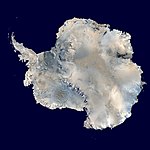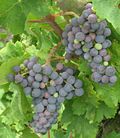| This Wikipedia page has been superseded by Portal:Chile and is retained primarily for historical reference. |
| Note: Article entries are now being transcluded directly on the main portal page. However, this page should be retained for historical reference. |
Selected article 1
Portal:Chile/Selected article/1

On average, Antarctica is the coldest, driest and windiest continent, and has the highest average elevation of all the continents. Since there is little precipitation, except at the coasts, the interior of the continent is technically the largest desert in the world. There are no permanent human residents and there is no evidence of any existing or pre-historic indigenous population. Only cold-adapted plants and animals survive there, including penguins, fur seals, mosses, lichen, and many types of algae.
The name Antarctica is a romanized version of the Greek compound word Αntarktiké (Aνταρκτική), meaning "Opposite of the Arctic". Although myths and speculation about a Terra Australis ("Southern Land") date back to antiquity, the first confirmed sighting of the continent is commonly accepted to have occurred in 1820 by the Russian expedition of Mikhail Lazarev and Fabian Gottlieb von Bellingshausen. However, the continent remained largely neglected for the rest of the 19th century because of its hostile environment, lack of resources, and isolation.
The Antarctic Treaty was signed in 1959 by twelve countries; to date, forty-five countries have signed the treaty. The treaty prohibits military activities and mineral mining, supports scientific research, and protects the continent's ecozone. Ongoing experiments are conducted by more than 4,000 scientists of many nationalities and with different research interests.
Selected article 2
Portal:Chile/Selected article/2

It is widely considered to be the southern tip of South America. Cape Horn is the most southerly of the great capes, and marks the northern boundary of the Drake Passage; for many years it was a major milestone on the clipper route, by which sailing ships carried trade around the world. However, the waters around the cape are particularly hazardous, owing to strong winds, large waves, strong currents and icebergs; these dangers have made it notorious as a sailors' graveyard.
The need for ships to round the horn was greatly reduced by the opening of the Panama Canal in 1914. However, sailing around the Horn is widely regarded as one of the major challenges in yachting, and a few recreational sailors continue to sail this route, sometimes as part of a circumnavigation of the globe, almost all of these choosing routes through the canals to the north of the actual Cape, though many take a detour through the islands and anchor to wait for fair weather to actually visit Horn Island or even sail around it to replicate a rounding of this historic point. Several prominent ocean yacht races, notably the Vendée Globe, sail around the world via the Horn, and speed records for round-the-world sailing follow the same route.
Selected article 3
Portal:Chile/Selected article/3

A member of the Cabernet family of grapes, the name "Carménère" originates from the French word for crimson (carmin) after the hue of the grape in fall. The grape is also known as Grande Vidure, a historic Bordeaux synonym, although current European Union regulations prohibit Chilean imports under this name into the EU. Along with Cabernet sauvignon, Cabernet franc, Merlot, Malbec and Petit verdot, Carménère is considered part of the original six noble grapes of Bordeaux, France.
Now rarely found in France, the world's largest area planted with this variety is in Chile in South America, with more than 4,000 Hectares (2006) cultivated in the Central Valley. As such, Chile produces the vast majority of Carménère wines available today and as the Chilean wine industry grows, more experimentation is being carried out on Carménère's potential as a blending grape, especially with Cabernet Sauvignon.
Carménère is also grown in Italy's Eastern Veneto and Friuli Venezia Giulia regions and in smaller quantities in the California and Walla Walla regions of the United States.
In Australia, 3 cuttings of Carmenère were imported from Chile by renowned viticultural expert Dr Richard Smart in the late 1990s. After 2 years in quarantine, only 1 survived the heat treatment to eliminate viruses and was micro-propagated (segments of individual buds grown on nutrient gel) and field grown by Narromine Vine Nursery. The first vines from the nursery were planted in 2002 by Amietta Vineyard and Winery in the Moorabool Valley (Geelong, Victoria) who use Carmenère in their Angels' Share blend.
Selected article 4
Portal:Chile/Selected article/4

Selected article 5
Portal:Chile/Selected article/5

Selected article 6
Portal:Chile/Selected article/6

Apart from this, the Puyehue-Cordón Caulle area is one of the main sites of geothermal exploration in Chile. Geothermal activity is manifested on the surface of Puyehue and Cordón Caulle as several hot springs and geysers. Cordón Caulle is also notable for having erupted following the 9.5 Mw 1960 Valdivia earthquake the largest recorded earthquake in history.
Selected article 7
Portal:Chile/Selected article/7

A South American dreadnought race between Argentina, Brazil, and Chile was kindled in 1907 when the Brazilian government announced their intention to purchase three dreadnoughts—powerful battleships whose capabilities far outstripped older vessels in the world's navies—from the British company Armstrong Whitworth. Two ships of the Minas Geraes class were laid down immediately with a third to follow. The Argentine and Chilean governments immediately canceled a naval-limiting pact between them, and both ordered two dreadnoughts (the Rivadavia and Almirante Latorre classes, respectively). Meanwhile, Brazil's third dreadnought was canceled in favor of an even larger ship, but the ship was laid down and ripped up several times after repeated major alterations to the design. When the Brazilian government finally settled on a design, they realized it would be outclassed by the Chilean dreadnoughts' larger armament, so they sold the partly-completed ship to the Ottoman Empire and attempted to acquire a more powerful vessel. By this time the First World War had broken out in Europe, and many shipbuilders suspended work on dreadnoughts for foreign countries, which halted the Brazilian plans. Argentina's two dreadnoughts were delivered, as the United States remained neutral in the opening years of the war, but Chile's two dreadnoughts were purchased by the United Kingdom. In the years between the First and Second World War, many naval expansion plans, some involving dreadnought purchases, were proposed. While most never came to fruition, in April 1920 the Chilean government reacquired one of the dreadnoughts taken over by the United Kingdom. No other dreadnoughts were purchased by a South American nation, and all were sold for scrap in the 1950s.
Selected article 8
Portal:Chile/Selected article/8

The Andean Condor (Vultur gryphus) is a species of South American bird in the New World vulture family Cathartidae and is the only member of the genus Vultur. Found in the Andes mountains and adjacent Pacific coasts of western South America, it has the largest wing span (at 3.2 m) of any land bird. The Andean Condor is a national symbol of Argentina, Bolivia, Chile, Colombia, Ecuador and Peru. It is the national bird of Bolivia, Chile, Colombia, and Ecuador. The Andean Condor can be found all over the Chilean cordillera from Parinacota to Torres del Paine National Park.
List of articles featured on the front page of Portal:Chile
- Antarctica on 2007-12-29 Portal:Chile/Selected article/1
- Cape Horn on 2007-12-29 Portal:Chile/Selected article/2
- Carménère on 2007-12-29 Portal:Chile/Selected article/3
- Easter Island on 2007-12-29 Portal:Chile/Selected article/4
- War of the Pacific on 2007-12-29 Portal:Chile/Selected article/5
- Puyehue-Cordón Caulle on 2009-10-18 Portal:Chile/Selected article/6
- Andean Condor on 2010-11-29 Portal:Chile/Selected article/8
- South American dreadnought race on 2011-12-13 Portal:Chile/Selected article/7 (replaced non-FA)